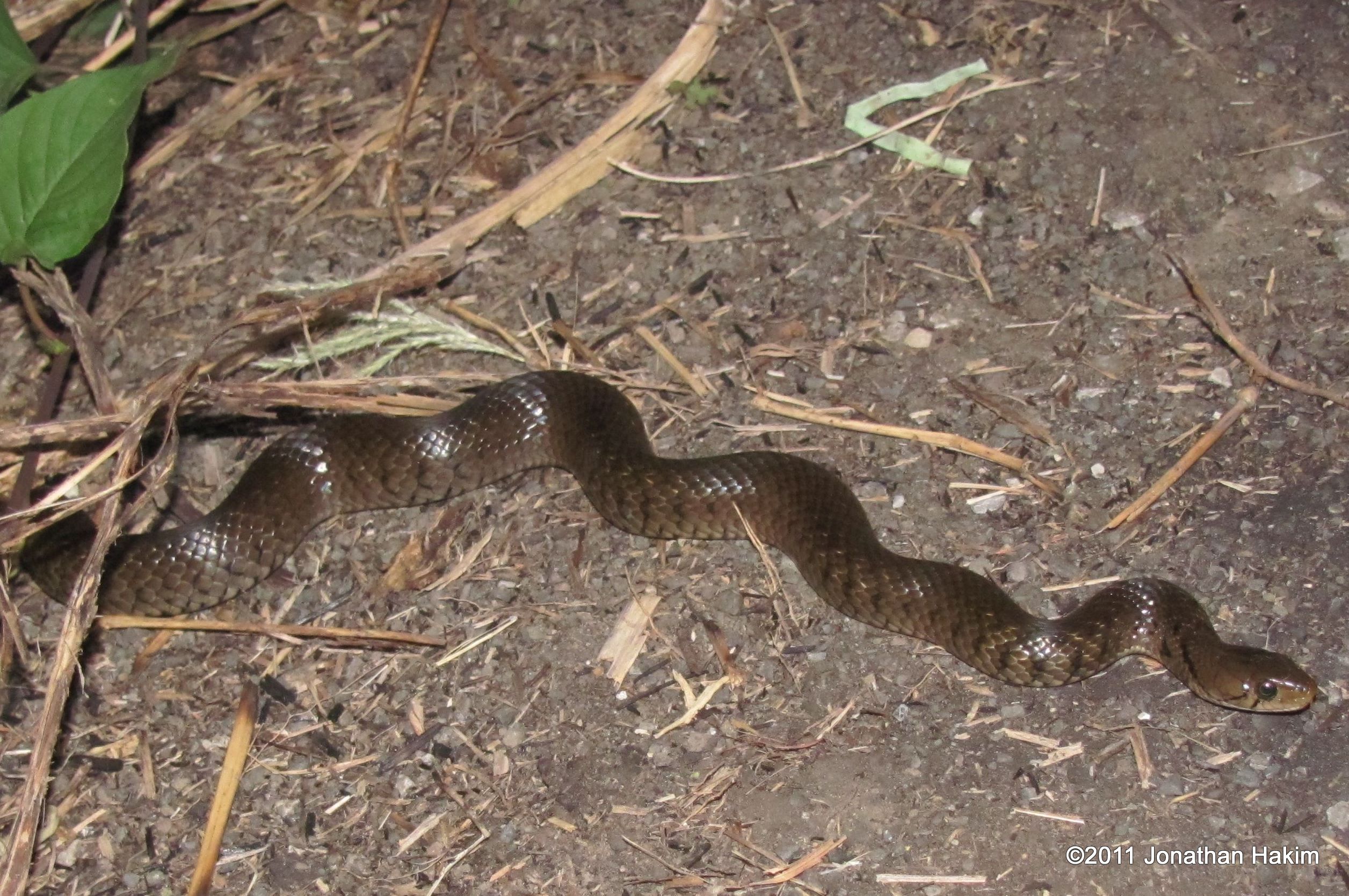Fowlea flavipunctatus


Prawet (Jon Hakim / CC BY-NC-SA) 
Phayao (Jon Hakim / CC BY-NC-SA) 
Nakhon Ratchasima (© Michael Cota) 
Ramkhamhaeng (Jon Hakim / CC BY-NC-SA)
English name: Yellow-spotted Keelback (aka “Common Keelback”)
Scientific name: Fowlea flavipunctatus (formerly Xenochrophis flavipunctatus)
Thai name: งูลายสอบ้าน (Ngu Lai Sor Baan)
Description: Up to 1m long. Body of average girth. Eyes are large. Olive-brown to gray with various black streaks and blotches that sometimes form a checkered pattern on the sides. Many specimens have rows of yellow, orange, or white dots or streaks. The conspicuous head has two black streaks come down and back from the eye to the lip, and a black line comes off the corner of the lip to join at the back of the neck and form a “V” or “Y”. Juveniles have a characteristic yellow mark on their neck that fades with age.
relevant scale counts: 19 midbody scale rows, scales are keeled strongest towards the back of the body.
Similar Species: Checkered Keelback has an inverted “V” on the neck with the point facing the head rather than the opening (or no mark at all), and is only found in northern Thailand and beyond.
Red-necked Keelback is more colorful and has a characteristic red neck. Juvenile Red-necked Keelbacks, which may not have developed the red neck yet, have a large black marking on the back of their neck that juvenile Yellow-spotted Keelbacks do not have.
Oriental Rat Snake lacks black markings on the front half of its body.
Range: Southeast Myanmar and south China through southeast Asia east to Taiwan and south to Singapore.
Habitat: In or near marshes, ponds, or rice patties, sometimes in the middle of urban areas.
Place in the ecosystem: The Yellow-spotted Keelback eats fish, frogs, and rodents, helping to control mouse and rat populations in the city. The juveniles are eaten by larger snakes and birds.
Danger to humans: Will bite aggressively when provoked and can draw blood, but is not dangerous to humans. Though it has no venom glands, some people report itching and slight swelling after a bite.
Conservation status and threats: No known conservation threats.
Interesting facts: The Yellow-spotted Keelback will often swallow its prey immediately upon catching it, without constricting or using any other means to kill the prey. As a result, prey is sometimes swallowed live, and some sources report frogs still vocalizing from within the snake.
References:
Snakes of Taiwan: Xenochrophis piscator
On the taxonomy of the Xenochrophis piscator complex
A revision of the species group of Xenochrophis piscator
A Photographic Guide to Snakes and Other Reptiles of Peninsular Malaysia, Singapore and Thailand
A Field Guide to the Reptiles of South-East Asia
Snakes of Thailand and their Husbandry
Simon & Schuster’s Guide to Reptiles and Amphibians of the World
Thailand has quite a variety of animals and I am always amazed by the diversity of wildlife I discover when I visit! I am not a snake expert but I always appreciate learning, thanks for the informative post.
Thank you!
Does this snake occur in green with a yellow under belly? I was bitten yesterday by a green snake, with a shinny skin as this one. But it had more of an arrow shaped head. It’s first bite felt like electricity and showed a sewing machine pattern, like it could not get a good bite. The second bite was a good one, but a quick hard kick dislodged it from the side of my foot. Could it have been a green cat snake. Any assistance would be greatly appreciated, it is obviously not poisonous, since I’m writing this. But I’m just curious. Currently in Ubon Ratchatani in North east Thailand. Thanks to any and all in advance!
It’s pretty difficult to say from that description. Many snakes will appear to have an arrow-shaped head while threatened or biting due to how their jaw can spread. And the lack of effects do not mean that it was not a venomous snake, as venomous snakes can sometimes give dry bites with no venomous effects.
There are a great number of green snakes in Thailand, including the whip snakes (Ahaetulla species), Golden Tree Snake, Red-tailed Green Rat Snake (also called Green Mountain Racer), Green Keelback, Green Cat Snake, and a number of green pit vipers. If you think it looks similar to a Yellow-spotted Keelback, then I would think a Red-tailed Green Rat Snake might be a likely bet.